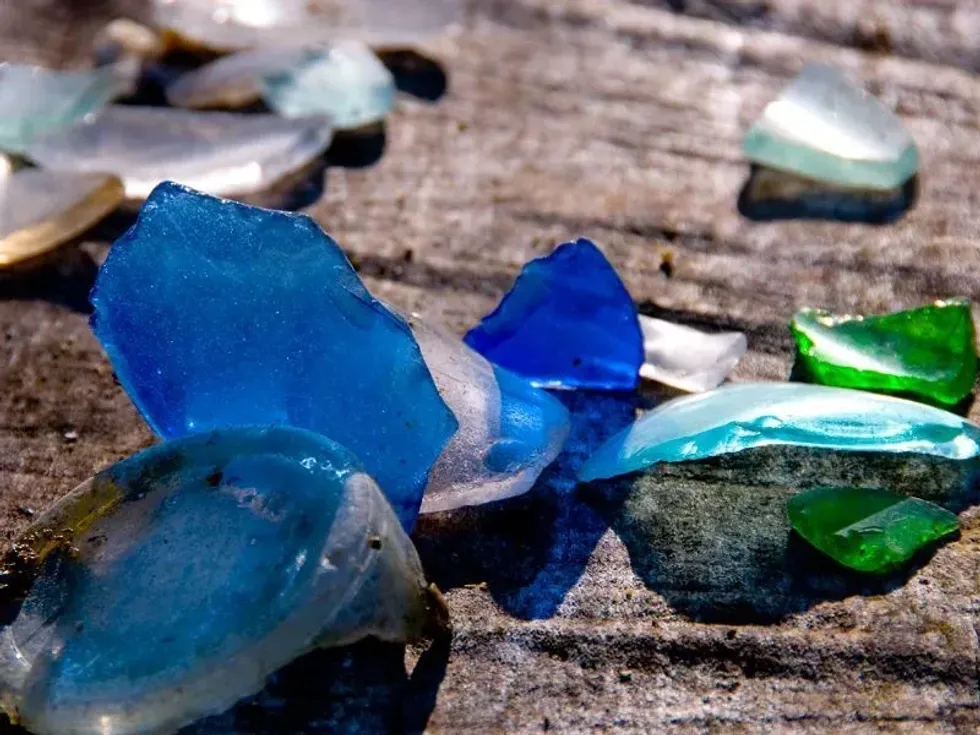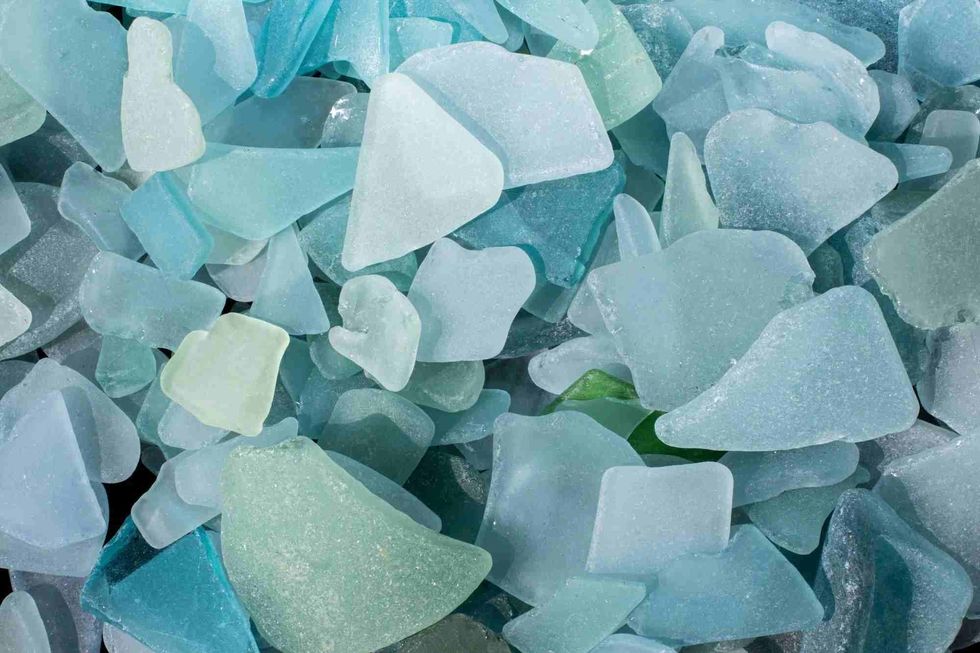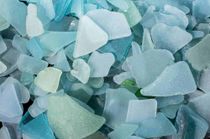How Is Sea Glass Made? How To Identify A Genuine Type Easily

Sea glass is a recycled gem found in the ocean.
Sea glass is an example of how nature can revive itself. Any glass pieces like glass bottles, broken bottles, medicine bottles, jars, or broken glass after being worn down in the ocean for a long period of time, the ocean can refine them into what we call sea glass.
Although genuine sea glass is very rare to find on the beach today, sea glass is a very popular jewelry material. Sea glass collectors find genuine sea glass at beaches around the world and collect them as sea glass stones or to make sea glass jewelry.
Sea glass is known as beach glass since the pieces of sea glass and sea glass gems are found on beaches. Sea glass is usually frosted with unique colors.
Sea glass products, like sea glass jewelry, are harder to find as recently sea glass gems have become rare. For the same reason, authentic sea glass has become more expensive.
Its rarity has given the opportunity to grow the sea glass jewelry industry, which has also given rise to the need for commercializing it. There were attempts to mass-produce artificial sea glass, jewelry manufactured with manufactured glass combined with a piece of sea glass.
The discovery of real sea glass is a natural miracle where trashed bottles, old bottles, glass bottles, and broken glass becomes frosted after many years under natural refining circumstances within the ocean, resulting in a smooth piece of glass.
These tumbled pieces of glass turn into sea glass and gems, which we can find on the beach near the ocean.
These pieces of glass found on the beach buried in the sand are the product of broken bottles and other waste tumbling through the ocean, frosted into smooth sea glass pieces created by the rock tumbler of nature.
Broken glass trashed inside the ocean or sea takes a long time to be tumbled and it remains in the water for more than a decade or maybe a century before it gets tumbled into smooth sea glass gems. These are completely natural and not man-made.
If you like this article why not take a look at how is rose gold made or how is quorn made here on Kidadl!
What is a sea glass?
A long time ago when there were no organized sewage systems to manage the huge amount of material waste from all over the world, people usually dumped it into the sea in the hope that it disappear.
Waste, including broken glass bottle or dishes or jars, tumbled across the shore into the earth and into the water along with the waves. Tumbling for a long period made their edges frosted, smooth and shiny.
This glass material then becomes a valuable piece of sea glass found on the shore of the beach in the sand.
Sea glass comes in various colors like green and blue and also in some rare shades.
It is used to make handmade jewelry and is also collected as gems from the beach as they have a smooth and shiny appearance, adding an exquisite look to a piece of jewelry.
In areas such as Fort Bragg, sea glass collectors generally locate real sea glass at beaches all around the world and collect it as a hobby or to manufacture sea glass.
Genuine sea glass is very rare to find today because broken glass or other waste glass material is not dumped into the sea directly anymore.
The natural rock tumbler doesn't have enough raw material to tumble more sea glass.
Due to the scarcity of real sea glass, new methods of producing synthetic sea glass have been discovered to make it sufficiently available in the commercial market which makes it harder to find genuine sea glass.
Sea glass can be tumbled at home with a piece of simple equipment and raw material, such as a glass bottle or old glass dishware, as well as arock tumbler, plastic bag, and some other safety tool.
However, the quality of the sea glass made from the natural tumbler (sea) is incomparable to the artificial ones.
This is the reason gemstone enthusiasts travel to all corners of the planet in search of a real piece of sea glass.
The beach is still the only source where sea glass tumbling in the sea can be found as it gets buried into the sand while tumbling back and forth into the sea and the shoreline.
Jewelry made from sea glass is a really beautiful piece of art as the sea glass adds extra grace to it.
Over the years, sea glass is becoming a rare gem of nature due to less dumping of waste material in the water bodies which is otherwise good for our environment, especially in times like this when the ecosystem of our planet is threatened globally.
Where are sea glasses found?
Sea glasses are found mainly on the shore of the sea on a beach, buried inside sand after tumbling for decades in the sea.
The reason why the beach is the main source of sea glass is that it hits the shore with the waves of the sea and washes off with them again, and this process is repeated several times moving many sea glasses on the shore from the sea.
Despite the fact that actual sea glass is extremely hard to locate on the shore nowadays, sea glass is a very popular jewelry material.
Sea glass enthusiasts often discover real sea glass on beaches throughout the world, such as Fort Bragg, and collect it as sea glass marbles or they use it to manufacture sea glass jewelry.
The finding of pure sea glass is a natural marvel when a trashed bottle, old bottle, glass bottle, or shattered glass has frosted over many years under natural refining conditions in the tumbler, creating smooth sea glass.
Sea glass may be found in a variety of colors, including green and uncommon hues. When there were no structured sewage systems to manage the massive quantity of material waste from all over the world, people used to throw it into the sea in the belief that it would drown.
The trash, which included shattered glass bottle, plates, and jars, washed up on the beach and washed into the sea with the waves.
Tumbling them over an extended length of time resulted in frosted, smooth, and glossy edges. This glass substance was then transformed into a precious piece of sea glass found in the sand on the beach's edge.
But in the present day, sea glass has become a rare gem as waste materials are not thrown so carelessly in the sea. Synthetic sea glass is produced to meet the demands of the consumers.
Synthetic sea glass is not in demand like real sea glass because they are too perfectly made unlike sea glass from the beaches that has a weathered look, having no perfect shape and a mystical essence, which is missing in the synthetic sea glass.
The main difference between real and synthetic sea glass is the authentic frosted look which is only observed in genuine sea glass.
The beauty of sea glass lies in the fact that unlike other valuable gems like gold, diamond, ruby, or silver which are extracted and produced by humans for their own demands, sea glass is made from the trash humans throw away into the sea. The sea refines the waste glass material into beautiful gemstones.
The completion of sea glass depends on many factors like the weather, the texture of the sand, the sea bottom, the pH value of the water, and most importantly time is a big factor here.
Time, tumbling, and seawater have all broken the waste down. The chemical composition of the glass has altered as a result of natural dehydration. Sea glass can come in all shapes and sizes, not in any perfect shape.
Triangular, oval, and heart-shaped sea glass pieces can be seen, and enthusiasts are more amused by the heart-shaped ones. Due to nature's refining process, the wasted glass becomes a gemstone. That is why sea glass is also called 'reverse gemstone'.

Sea Glass Vs Beach Glass
Sea glass and beach glass are terms used interchangeably in many places. Technically the two gems are different in some ways and similar in many other ways.
When glass bottles, shattered bottles, medicine bottles, jars, broken glass, and old bottles are tossed into the ocean and are there for a long time, the water tumbles them into jewels known as sea glass.
Sea glass comes in a variety of hues, including green and blue, as well as some unusual tints. It is used to produce handcrafted jewelry and is also gathered as beach gems because it has a smooth and glossy appearance, giving a piece of jewelry an excellent aspect.
Sea glass items, such as sea glass jewels, are becoming increasingly difficult to locate since sea glass has lately become scarce, and as a result, real sea glass has grown more expensive.
However, its scarcity has given rise to cottage industries such as the sea glass jewelry industry, which has also given rise to the need for commercializing sea glass jewelry.
There have been attempts to mass-produce synthetic sea glass, that is jewelry made from manufactured glass combined with a piece of sea glass.
The beauty of sea glass comes from the fact that, unlike other precious jewels such as gold, diamond, ruby, or silver that are mined and created by people for their own needs, sea glass is generated from rubbish discarded by humans in the sea.
Sea glass may come in a variety of forms and sizes, and there is no such thing as a perfect shape. There are triangular, oval, and heart-shaped sea glass pieces to be found, with the heart-shaped ones proving to be the most popular.
Many elements influence the completion of sea glass, including the weather, the texture of the sand, the sea bottom, the pH value of the water, and, most significantly, time.
The true frosted texture that can only be seen in genuine sea glass distinguishes it from fake sea glass. The rarest sea glass type or color is actually orange!
Beach glass is just like sea glass in the aspect of origin. It is also tumbled from waste glass material thrown in fresh water, not in saltwater.
It differs a little in appearance from sea glass, as the former is less frosted than the latter.
In terms of quality and value, both beach glass and sea glass are the same and in fact, many people use these words interchangeably as they are almost similar. Beach glass is also used for the same reason as sea glass, for making gemstone jewelry, and also collected by people as a natural beauty.
In recent posts, we came to know that the refining process of the sea glass and beach glass is different due to the surrounding conditions.
The pH level is different in fresh water and saltwater and also the bottom of fresh water varies in nature from the sea. Other than these small variations, beach glass is similar to sea glass.
Is collecting sea glass illegal?
Sea glass has become a rare treasure in recent years since waste items are no longer dumped indiscriminately into the sea. As a result, recent posts show that synthetic sea glass is created to fulfill customer demand.
Synthetic sea glass is not as popular as natural sea glass because it is too precisely produced, as opposed to beach sea glass, which has a worn appearance, no perfect shape, and a magical essence that synthetic sea glass lacks. The true frosted appearance that can only be seen in genuine sea glass distinguishes it from fake sea glass.
So to protect this natural treasure from being overused, on some beaches, collecting sea glass is illegal.
Although collectors do not obey these restrictions in many places, collecting a harmless quantity of these beautiful gems is still considerable. It's worth the money if you wish to own a gem crafted by nature.
However, its scarcity has given rise to cottage industries such as the sea glass jewelry industry, which has also given rise to the need for commercializing sea glass jewels.
Rhere have been attempts to mass-produce artificial sea glass, that is jewelry made from man-made glass combined with a piece of sea glass.
The finding of genuine sea glass is a natural marvel in which trashed bottles, old bottles, glass bottles, and shattered glass frosted over many years under natural refining conditions in the water create a smooth piece of glass.
Sea glass may be found in a variety of colors, including green and other rare colors. Many elements influence the completion of sea glass, including the weather, the texture of the sand, the sea bottom, the pH value of the water, and most significantly, time.
Time, falling, and seawater have all dissolved it. Natural dehydration has changed the chemical makeup of the glass.
Sea glass may come in a variety of forms and sizes, and there is no such thing as a perfect shape. There are triangular, oval, and heart-shaped sea glass pieces to be found, with the heart-shaped ones proving to be the most popular.
The discarded glass becomes a gemstone as a result of nature's refining process. This is why sea glass is sometimes known as a 'reverse gemstone'.
Despite the fact that genuine sea glass is exceedingly difficult to find on a beach shore these days, sea glass is a popular jewelry material.
Sea glass aficionados frequently find actual sea glass on beaches across the world, including Fort Bragg, and collect it as sea glass marbles or to make sea glass jewels. Jewelry created from sea glass is a very lovely work of art because the sea glass lends a touch of elegance to it.
However, owing to decreased dumping of waste stuff in the water over the years, sea glass has become a unique jewel of nature, which is otherwise beneficial for our environment, especially at a time when our planet's ecology is under attack internationally.
Here at Kidadl, we have carefully created lots of interesting family-friendly facts for everyone to enjoy! If you liked our suggestions for how is sea glass made then why not take a look at how is propane made or how is root beer made.
We Want Your Photos!
More for You
See All
Bachelor of Science specializing in Nautical Science

Ayan BanerjeeBachelor of Science specializing in Nautical Science
Thanks to his degree in nautical science from T.S. Chanakya, IMU Navi Mumbai Campus, Ayan excels at producing high-quality content across a range of genres, with a strong foundation in technical writing. Ayan's contributions as an esteemed member of the editorial board of The Indian Cadet magazine and a valued member of the Chanakya Literary Committee showcase his writing skills. In his free time, Ayan stays active through sports such as badminton, table tennis, trekking, and running marathons. His passion for travel and music also inspire his writing, providing valuable insights.
Bachelor of Arts specializing in English Literature, Masters of Art specializing in English and Communication Skills

Sonali RawatBachelor of Arts specializing in English Literature, Masters of Art specializing in English and Communication Skills
Sonali has a Bachelor's degree in English literature from Guru Gobind Singh Indraprastha University and is currently pursuing a Master's in English and Communication from Christ University. With considerable experience in writing about lifestyle topics, including travel and health, she has a passion for Japanese culture, especially fashion, and anime, and has written on the subject before. Sonali has event managed a creative-writing festival and coordinated a student magazine at her university. Her favorite authors are Toni Morrison and Anita Desai.
Disclaimer
1) Kidadl is independent and to make our service free to you the reader we are supported by advertising. We hope you love our recommendations for products and services! What we suggest is selected independently by the Kidadl team. If you purchase using the Buy Now button we may earn a small commission. This does not influence our choices. Prices are correct and items are available at the time the article was published but we cannot guarantee that on the time of reading. Please note that Kidadl is a participant in the Amazon Services LLC Associates Program, an affiliate advertising program designed to provide a means for sites to earn advertising fees by advertising and linking to Amazon. We also link to other websites, but are not responsible for their content.
2) At Kidadl, we strive to recommend the very best activities and events. We will always aim to give you accurate information at the date of publication - however, information does change, so it’s important you do your own research, double-check and make the decision that is right for your family. We recognise that not all activities and ideas are appropriate for all children and families or in all circumstances. Our recommended activities are based on age but these are a guide. We recommend that these ideas are used as inspiration, that ideas are undertaken with appropriate adult supervision, and that each adult uses their own discretion and knowledge of their children to consider the safety and suitability. Kidadl cannot accept liability for the execution of these ideas, and parental supervision is advised at all times, as safety is paramount. Anyone using the information provided by Kidadl does so at their own risk and we can not accept liability if things go wrong.
3) Because we are an educational resource, we have quotes and facts about a range of historical and modern figures. We do not endorse the actions of or rhetoric of all the people included in these collections, but we think they are important for growing minds to learn about under the guidance of parents or guardians.







